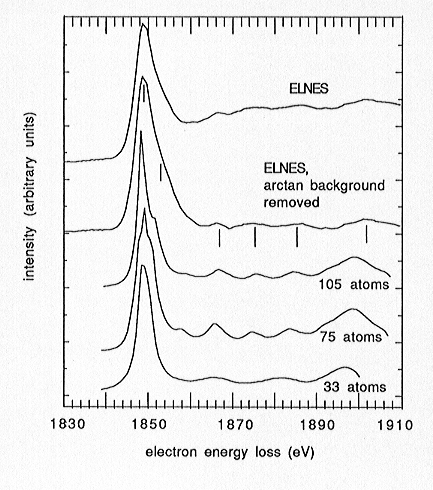

ELNES (Electron Loss Near Edge Structure) spectroscopy is a powerful tool for the structural characterization of both crystalline and amorphous substances on a nanometer scale. Similar to XANES, but with nearly atomic resolution, ELNES provides information on coordination number, polyhedral distortion, short- and long-range order, and valence for any element with Z > 2. The method is, therefore, particularly suited for materials recovered from high-pressure experimentation, which typically are fine-grained and multiphase. Because of the very high spatial resolution, ELNES can also be applied to the structural characterization of defects and interfaces. A further advantage of the method is the measurement of ELNES spectra in the transmission electron microscope, i.e. symmetry information via diffraction, microtextural observation by imaging, and chemical analysis via ATEM can be obtained from the same grain as the ELNES spectra.
As in the case of XANES, ELNES spectra have mostly been interpreted by comparing them to those of well-characterized substances, that is, by fingerprinting. However, even for determining the coordination number of an element, this approach has its pitfalls, for instance when small and highly charged cations are present in the second coordination sphere.
Recent progress in multiple scattering calculations has made it possible to calculate theoretical spectra by ab-initio methods from positional parameters. In this project we compare theoretical spectra to those of quartz, coesite, and stishovite, which are used as examples of chemically simple substances with Si in either tetrahedral or octahedral coordination. Questions to be answered are:
- which form of a potential should be used to best fit the calculations to the experimental spectra ?
- what is the minimum cluster size necessary to achieve good agreement, or, conversely, what is the characteristic length scale of the ELNES spectra ? How much information from second, third, etc. coordination spheres is contained in the spectra ?
The goal thus is to explain the spectra rather than describing them empirically.
By comparing experimental and calculated spectra it can be shown that
the gross features of the Si K- and L-edge ELNES spectra are produced by
the first coordination shell, i.e. the coordination number and symmetry
of the oxygens surrounding the Si atom; on the other hand calculations
indicate that the overall topology of edges are insensitive to Si-O bond
length. For instance, an isolated SiO6 cluster yields a single
strong peak for the Si K-edge, whereas a SiO4 cluster produces
two strong peaks, as observed in the spectra of stishovite vs. quartz or
coesite. This sensitivity to the first coordination sphere should allow
the determination of Si coordination numbers in unknown phases. On the
other hand, the fine structures in the spectra, present as weak peaks above
the edge or as shoulders, can only be accounted for by including outer
coordination spheres into the calculations. Optimum correspondence between
the observed fine structure and the calculated spectra was achieved by
using the Xα-type potential with the exchange
parameter α set to 0.828, and for cluster sizes
of at least 50 atoms, corresponding to a cluster radius of about 5 Å
(Fig. 3.3-6). Increasing the cluster radius significantly beyond this value
produces little change. Despite the restricted length scale of observation,
ELNES spectra are thus sensitive to both short-range and long-range order,
plus polyhedral linkage etc. We plan to explore the latter aspect by measuring
and calculating Si K- and L-edge spectra of the high-pressure MgSiO3
polymorphs ilmenite and perovskite, which exhibit corner-sharing and face-sharing
of the SiO6 polyhedra, and comparing them to the spectra of
stishovite, in which the SiO6 polyhedra share edges.
 |
Fig. 3.3-6: Comparison of observed ELNES and calculated Si K-edge spectra of stishovite. Vertical bars in the experimental spectrum correspond to peak maxima determined by fitting. |

Tel: +49-(0) 921 55 3700 / 3766, Fax: +49-(0) 921 55 3769, E-mail: bayerisches.geoinstitut(at)uni-bayreuth.de
 Previous page
Previous page